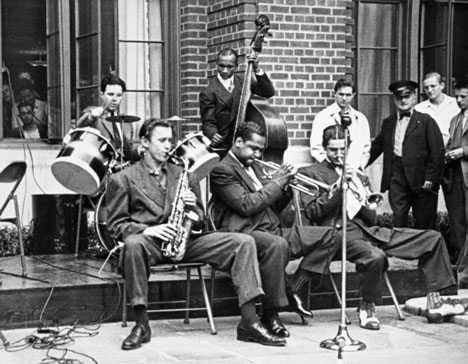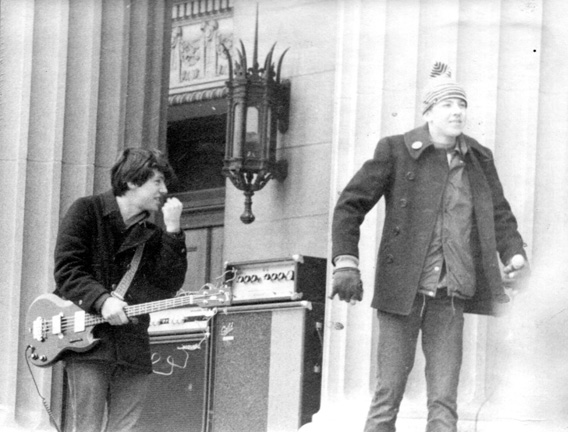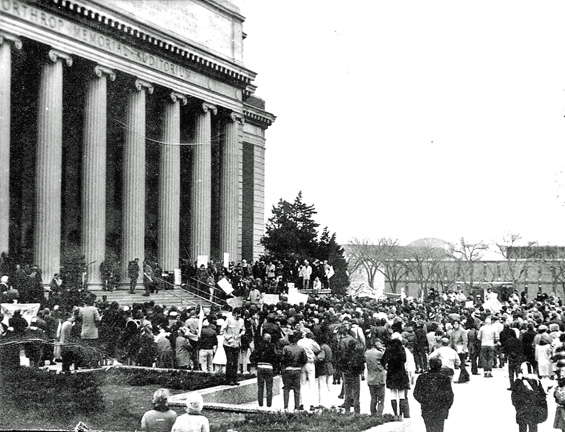University of Minnesota
This page is intended to cover a variety of places on the East Bank of the U of M. Please see separate pages for:
Many of these events took place outside, usually in front of Coffman Memorial Union (CMU) or Northrop Auditorium. As usual, they will be listed in chronological order as I’ve found them, and the list stops after 1974. Although there was a lot going on, especially during the turbulent days of the Vietnam War, I am trying to keep this page to musical events. For more information about anti-war protest activities, you may want to look at my page on the Vietnam War on the St. Louis Park Historical Society’s website. It has a skew towards SLP, but it also tries to relate the major actions of the war and the protest at the U of M, as told by activist Ed Felien.

1941 photo Courtesy Minnesota Historical Society
Above is a scene from outside CMU: Tom Morgan on Sax, Ira Pettiford on trumpet, Dale Olinger on trumpet, Oscar Pettiford on bass, drummer unknown.
1944: Al Wiklund taught jitterbug lessons at CMU.
1950s
The U of M held its Black Book Dance on April 25, 1952, in the Union’s Main Ballroom with music by Dick Kast and his Orchestra. In an ad in the Minnesota Daily, Men and/or Boys were invited to meet “Stenos, Models, Nurses, Receptionists and Coeds; – over 2500 girls attended last year’s dance,” it promised. “Friday is Your Night to Make Out!” Apparently this was an escapade of the Engineering school, which in the ’50s was bereft of women. At the dance Queen Colleen of the Engineers would be crowned, and the boys were exhorted to fix up dates for the engineers’ crawl on May 10. At some point in this silliness the engineers would present the opera “Il Cuspidore.”
U of M President J.L. Morill banned Paul Robeson from performing at the University, calling him an “embittered, Anti-American, Anti-democratic propagandist.” Robeson was not deterred, performing at the Union Men’s Ballroom (could this be the CIO Hall?) on June 3, 1952, in a show sponsored by the Young Progressives of America, reported the Minnesota Daily.
The U of M’s Homecoming Dance featured the Four Aces on November 1, 1952. There were also three orchestras.
Songstress Sunny Gale was the featured artist at the 1953 Sno Ball at the U of M, January 24, 1953.
Buddy Morrow played at the Stardust Dance on April 18, 1953, at the U of M.
Felicia Sanders, the Voice of Moulin Rouge at the Radisson Hotel, appeared at a dance at the Union Ballroom at the U of M on October 8, 1953.
The 1953 Homecoming Dance at the U of M featured Freddy Martin and his Singing Sax in the main ballroom, Doc Evans in the main lounge, Bill Lawrence and Dick Finch in the Armory, and Dick Marrone in the Cafeteria. All this on November 7.
Ray Anthony played for the Sno-Ball on January 22, 1954, at the U of M Union Ballroom.
Louis Armstrong provided the music for the Stardust Dance at the U of M on April 24, 1954.
BEATNIKS IN THE CITIES?
The October 1, 1959 Trib posed the question: “Does the Twin Cities have its share of beatniks? The people interviewed were skeptical:
- Suzanne Wolfe said “Yes, even if the majority of beatniks aren’t serious about it. There are a number of beatniks at the U of M. They wear trench coats and goatees.
- Errol Kantor said “No. Most beatniks are out in California. The fellows at the University who wear trench coats and goatees are all pseudo-intellectuals.
- Sonja Blagen thought Minneapolis had its share but that St. Paul didn’t have one beatnik joint.
- Matthew Levison, a student at the U, said “No. Perhaps 10 percent of those popularly known here as ‘beat’ are actually so. The balance are nothing more than hangers-on. Beat movement is entirely nihilistic in 20th century tradition. Its center is New York and the West Coast.
- Bonnie Erickson made the decision unanimous: “The concentration of individualistic existentialists, as I prefer to call the ‘beatniks,’ is definitely in Minneapolis. Only a few are sincere iconoclasts. Fakes who claim to be beatniks do it for attention, rather than for a purely esthetic cause.
In 1959, no rock ‘n’ roll was played on radio station WMMR, which was broadcast from Coffman Union to the dorms. Park senior Irwin Gold a/k/a Dean Curtis reported that its repertoire was easy listening and swing.
1960s
The Trashmen played a rare local gig at a Hawaiian Surfari at Coffman Union at the U of M. With special entertainment: exotic dancer LaLoni! Prizes for the Swingingest Hula Dancer, Brightest Shirt, Brightest Muu Muu. April 30, 1965.
The Trashmen were back at the U on September 20, 1965.
Herb Alpert, Blue Cheer and the Castaways (an odd grouping to say the least) played Williams Arena at the U of M on May 11, 1968. Nearly 17,000 attended.
MY LAI MASSACRE
The My Lai Massacre, which took place in March 1968, hit the media in November 1969 and was responsible for people calling veterans “baby killers” upon their return to the States. The news precipitated the International Student Strike Against the Vietnam War on November 13, 1969.
First, the band Phantasmagoria played on Northrop Plaza from 11:00 to noon. The band was made up of students from St. Paul Murray High School, including Arne Shulstad, who reported – then and now – that it was really too cold in November to be playing guitar outside. The Minnesota Daily – and I – will delicately delete the expletives. Arne says, “We got that gig because a friend of our bass player was in the Socialist Workers Party, which was partnered with the Student Mobilization Committee to End the War in Vietnam.”

Phantasmagoria. Photo Courtesy Arne Shulstad
Then came a noon rally at Northrop Auditorium with speeches.

Next, demonstrators marched to the Old Federal Office Building in downtown Minneapolis. The 20-degree weather and a blustery wind kept the crowd to about 2,500, down from the 10,000 that gathered on October 15, 1969. The crowd was reported to be mostly high school and college aged.
There was a 4:30 dance at CMU featuring local band Showtime I and II.
After a night rally at the Minneapolis Auditorium, the Tribune reported that “the first of an expected 1,000 or more Minnesotans left Thursday night for the mass antiwar march in Washington, DC on Saturday.” The first bus to leave carried students from Macalester College, St. John’s College, St. Benedict’s College and the University of Minnesota.
More on the Vietnam war at home, focusing on St. Louis Park, is available here.
1970s
Pepper Fog played at Coffman Union on January 13, 1970, at 8:00 pm.
Crow and Abraxis performed at Coffman Union on February 6, 1970.
CAMBODIA
U.S. and South Vietnamese forces invaded Cambodia on April 30, 1970. On May 1 President Nixon announced the expansion to the public. U.S. troops could go no further than 19 miles into the country, for no longer than 2 months. A student strike at the University on May 4, 1970, drew 8,000 people outside the student union lasting one week and involving one-fifth of the student population. Demonstrations took place for a week. On May 4, 1970, at Kent State University, a similar demonstration took place, but ended in tragedy when Ohio National Guardsmen opened fire on protesting students, killing four and wounding nine others. At least some of those killed turned out to be onlooking students, not protesters.
On Saturday, May 9, 1970, a March for Peace started at Hamline University and ended at the Capitol, with the slogan “No Business as Usual.” An estimated 40,000 people participated in the march, which was organized by Barry Knight. At the end of the march participants heard speakers such as Indian activists Clyde Bellecort and Dennis Banks, and the Paisleys entertained the crowd.
Big Mama Thornton appeared at the Walker (or Coffman Union?) on May 6, 1970.
U of M held a series of blues concerts on the Anderson Hall Mall. Mississippi Fred McDowell performed to an audience of 1,200 on July 22, 1970.
Jesse “Lone Cat” Fuller, a 75-year-old black blues singer and musician, performed at Eddy Hall Knoll, East Bank of the U of M, on June 30, 1971, reported the Star. “His performance on the guitar, kazoo, harmonica and fotdella (an invention of his own) is one of laughing, dancing, happy songs.” He decided on the one-man-band concept in 1951 when he wanted to form his own band but found it difficult to find dependable, capable musicians.
